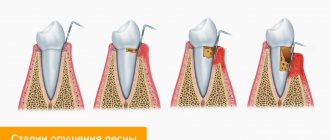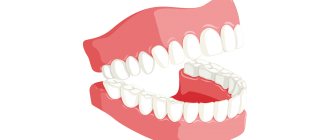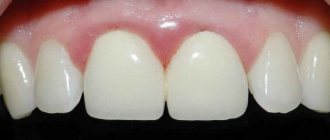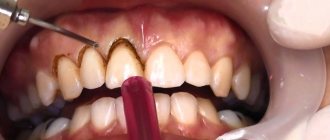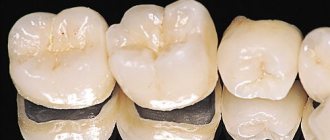Author of the article:
Soldatova Lyudmila Nikolaevna
Candidate of Medical Sciences, Professor of the Department of Clinical Dentistry of the St. Petersburg Medical and Social Institute, Chief Physician of the Alfa-Dent Dental Clinic, St. Petersburg
White spots on the gums or plaque on the mucous membranes of the mouth are an extremely common symptom that occurs in patients of any age. This phenomenon can be a sign of both relatively harmless gum diseases and severe pathologies, including cancer. You will learn about what diseases can cause the appearance of spots and plaque from our material.
General overview
Extraction of an element of the dentition is a process during which the gums receive extensive trauma. Tooth extraction leads to rupture of nerves and ligaments, as well as destruction of small blood vessels, resulting in local bleeding. This process is natural in nature and is a protective mechanism - the blood limits the possibility of pathogenic bacteria entering the socket that can cause infection. During the folding process, a reliable barrier is formed that protects the internal tissues until complete recovery. The formation of white plaque is a normal phenomenon, since it is not a purulent structure, but an element necessary for the regeneration of the jaw region.
When undergoing tooth extraction surgery, you should prepare in advance for possible consequences, the list of which includes:
- Moderate bleeding that persists for several hours;
- Formation of a dense blood clot over the socket;
- Unpleasant odor that occurs 10-12 hours after the procedure;
- Formation of a white coating on the surface of the blood clot;
- Painful manifestations in the area of intervention;
- Increased body temperature.
These symptoms are not pathological in nature and are a normal reaction of the body to radical intervention.
What do pale gums on a dog mean?
Healthy mucous membranes
The color of a dog's gums is one of the most important indicators of a pet's health.
The gums play the role of a protective barrier in the dog's body. If you feel well, your gums will be pink or light pink. However, if your dog is feeling unwell, changing gum color can help spot and prevent the threat. Examine your pet's healthy gums while the dog is awake and at rest. Take a good photograph of your gums in good lighting. This way, if there are problems, you can quickly demonstrate to your veterinarian why the color of your gums is causing you concern.
Each dog's gum color is different. If, in good health, the gums of your four-legged friend are not pink, but slightly darker or lighter and have always been this way, then this is the norm specifically for your pet. Many dogs have partially dark gums; in this case, use the color of the unpigmented areas as a guide.
Check your dog's gums and teeth regularly. Healthy gums feel moist and slippery to the touch. When you press on the gum, it turns pink again within two seconds. This is a sign of good capillary circulation.
Not only gums and oral tissues, but also other mucous membranes can tell about the dog’s condition. If you suspect something is wrong, evaluate the appearance of the visible mucous membranes of the pet’s eyes, ears and genitals.
When you need urgent help
What does pale gum color on a dog mean? About the need to assess her well-being: are there any other alarming symptoms, were there any injuries or incidents that could harm your pet? If the gums are unhealthy, exclude rough and cold foods from his diet.
Pale gums in a dog are not a disease, but a possible signal of illness. The diagnosis can be made by a veterinarian based on a combination of symptoms, tests, examinations, and the patient’s medical history.
Pale gums can be a symptom of many different diseases. This list includes heart failure, gastric dilatation, and the presence of a foreign body in the respiratory tract. Therefore, it is important to understand exactly what reason affected the appearance of the gums.
White gums may indicate anemia (anemia), as well as blood loss, internal bleeding, intoxication, infection with internal parasites, insufficient oxygenation of the blood, or lack of hemoglobin, an iron-containing blood protein. Gum color that is too light in dogs can be caused by pneumothorax, an accumulation of air in the pleural cavity that interferes with normal lung function and gas exchange during breathing.
Pale gums may be accompanied by lethargy, apathy, poor appetite, refusal to walk and play, cough, shortness of breath, and changes in body temperature. Such symptoms indicate that the dog urgently needs to be shown to a veterinarian. An unnaturally light color of the gums may indicate a pet’s deep state of shock - in such a situation, the help of a doctor is also needed. You won't be able to figure out what's wrong on your own. Therefore, take your pet to a veterinarian as soon as possible.
If your pet loses consciousness, first call your veterinarian and describe the situation. The specialist who sees your pet will instruct you on the necessary measures.
Delay and attempts to independently help your pet at home are extremely dangerous. But if your pet cuts itself, then before visiting a doctor you should treat and bandage the wound to stop the bleeding.
Mandatory visit to the veterinarian
If your dog is alert, active, sociable and eating well, pale gums will still be a sign that you need to take your pet to the veterinarian. Not urgently, but in the near future. It can be assumed that in this case we will talk about replenishing the lack of vitamins in the body and preventive measures. Sometimes the prerequisites for the development of anemia in a pet are a lack of iron and folic acid.
Be careful when walking your dog. The gums may become pale if the pet is cold and if the dog eats snow. If after a walk in frosty weather your dog’s gums turn pale, take him into a warm room, warm him up, and give him a warm drink. Place a heating pad or a bottle of warm water under your side. Stroke the dog's fur, calm it down, talk to it kindly. If it is only a slight hypothermia, the gums will soon return to a healthy pink color.
We wish your pets health!
What is a white coating on a wound?
Two to three hours after extraction of the problem unit, a dark clot of blue, black or red color forms in the alveolar socket. This is a bloody secretion that forms the primary barrier to protect the socket from external elements and pathogenic bacteria. After several days, a coating appears on the surface of the clot - with a characteristic yellow, white or gray tint, externally resembling suppuration, and having a specific odor. However, this is not actually pus, but a special protein-based compound known in dentistry as fibrin.
The structure of the plaque can vary from soft to very dense. Preserving the integrity of the film allows for the development of natural processes beneath its surface:
- Gradual resorption of the blood clot:
- Reducing the diameter of the alveolar socket;
- Displacement of new cells - osteoblasts - to the central part;
- Closing the wound with regenerating gum tissue.
The formation of fibrinous plaque is a necessary process, important from the point of view of restoration of the body in the period after tooth extraction.
Anemia
Anemia occurs when the body does not receive enough blood. Lack of blood can cause some tissues to become pale. In addition to pale gums, other symptoms may appear:
- Unexplained fatigue and weakness;
- Dyspnea;
- Pale or yellowing of the skin and whites of the eyes;
- Headache;
- Cardiopalmus.
Anemia often occurs due to a lack of iron, folic acid, or vitamin B-12. In addition, a person may have too few blood cells or not enough hemoglobin. In people with sickle cell disease, the blood cells are abnormally shaped.
Why you don't need to remove white plaque
Careless performance of oral hygiene procedures can cause damage or removal of the protective film. A number of negative processes result from the destruction of the barrier:
- Opening a wound for access of pathogenic microorganisms that provoke inflammation and infect the body’s circulatory system;
- Increased pain caused by the sensitivity of unprotected tissues to any form of external influence;
- Reopening of bleeding and increasing the duration of healing of the alveolar socket.
Accidental damage can be avoided by following medical recommendations.
How to maintain the integrity of white plaque after tooth extraction?
Reducing the risk of developing complications that occur against the background of exposure of the tooth extraction site involves following the following instructions:
- Abstain from drinking and eating for three hours from the end of the operation;
- Avoiding increased temperature in the affected gum area, including overheating as a result of taking a bath or visiting a sauna;
- Temporary cessation of bad habits, including smoking and drinking alcohol;
- Observe a daily break in relation to the procedure of rinsing the mouth and brushing the teeth;
- Reduce physical activity for the entire recovery period.
In situations where the pain after removal of the unit remains noticeable and causes severe discomfort, it is permissible to take painkillers prescribed by the attending physician. If you detect uncharacteristic discharge, which is a liquid mass, the spread of swelling to the gum tissue, as well as an increase in temperature to 38 degrees, you should immediately seek help, since these symptoms may indirectly indicate the development of infection or complications.
Clinical researches
As a result of clinical experiments using the Asepta series of products, which were carried out at the Kazan State Medical Academy N.V. Berezina, E.N. Silantieva, S.M. Krivonos, the effectiveness of the Asepta line of drugs has been proven as a means of etiotropic and symptomatic therapy as part of the complex treatment of patients with chronic inflammatory periodontal diseases.
Sources:
- The use of drugs from the Asepta line in the complex treatment of inflammatory periodontal diseases (N.V. Berezina E.N. Silantyeva S.M. Krivonos, Kazan State Medical Academy. Kazan.) N.V. BEREZINA, E.N. SILANTIEVA, S.M. KRIVONOS Kazan State Medical Academy
- The effectiveness of the use of Asept “adhesive balm” and Asept “gel with propolis” in the treatment of chronic generalized periodontitis and gingivitis in the acute stage (Municipal Dental Clinic No. 4, Bryansk, Kaminskaya T. M. Head of the therapeutic department Kaminskaya Tatyana Mikhailovna MUZ City Dental Clinic No. 4, Bryansk
- The effectiveness of the use of Asepta balm in the treatment of patients with inflammatory periodontal diseases (Doctor of Medical Sciences, Professor Elovikova T.M., Department of Therapeutic Dentistry, USMU. Yekaterinburg) Doctor of Medical Sciences, Professor Elovikova T.M. Department of Therapeutic Dentistry, USMU. Ekaterinburg
- Report on clinical trials to determine/confirm the preventive properties of commercially produced personal oral hygiene products: mouth rinse "ASEPTA PARODONTAL" - Solution for irrigator." Doctor of Medical Sciences Professor, Honored Doctor of the Russian Federation, Head. Department of Preventive Dentistry S.B. Ulitovsky, doctor-researcher A.A. Leontiev First St. Petersburg State Medical University named after academician I.P. Pavlova, Department of Preventive Dentistry.

